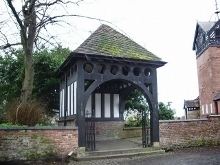OS grid reference SJ 773 930 Denomination Anglican Opened 1887 Designated as world heritage site 11 November 1966 | Country England Functional status Active | |
 | ||
Website St Martin, Ashton upon Mersey | ||
St Martin's Church is in Church Lane, Ashton upon Mersey, a district of Sale, Greater Manchester, England. It is recorded in the National Heritage List for England as a designated Grade II* listed building. It is an active Anglican parish church in the diocese of Chester, the archdeaconry of Macclesfield and the deanery of Bowdon.
Contents
History
The first church, probably timber-framed, was built in 1304 on the site of an old Saxon burial place. In 1704 it was destroyed by a storm. A new church was built in 1714 for Joshua Allen. In 1874 a baptistery by W. H. Brakspear was added. In 1886, the turret and clock were removed and the following year a new tower was built, it was designed by George Truefitt for Sir Williams Cunliffe Brooks. In the same year a ring of 13 bells was installed and a new lych gate was built.
Exterior
The church is built in Lymm sandstone with slate and tile roofs. Its plan consists of a wide nave of four bays, a south porch, a north baptistery, and a chancel with an adjoining tower containing a vestry to the south. The tower is square, its top stage being timber-framed. It contains a clock face to the south, gables on each side and an elaborate weather vane. The baptistry is octagonal with a pyramidal roof.
Interior
At the west end is a gallery. The roof is double hammer beam in type. The chancel walls are panelled with the ends of former box pews. One font dating from the 16th century on a 20th century shaft is wrongly dated 1304. Another font dates from the 18th century. The parish chest is long and narrow, and is dated 1706. On the walls are a number of memorial tablets. The parish registers date from 1631 but are not complete and are in part difficult to decipher. The stained glass in the east window was given in 1862 by James Occleston.
